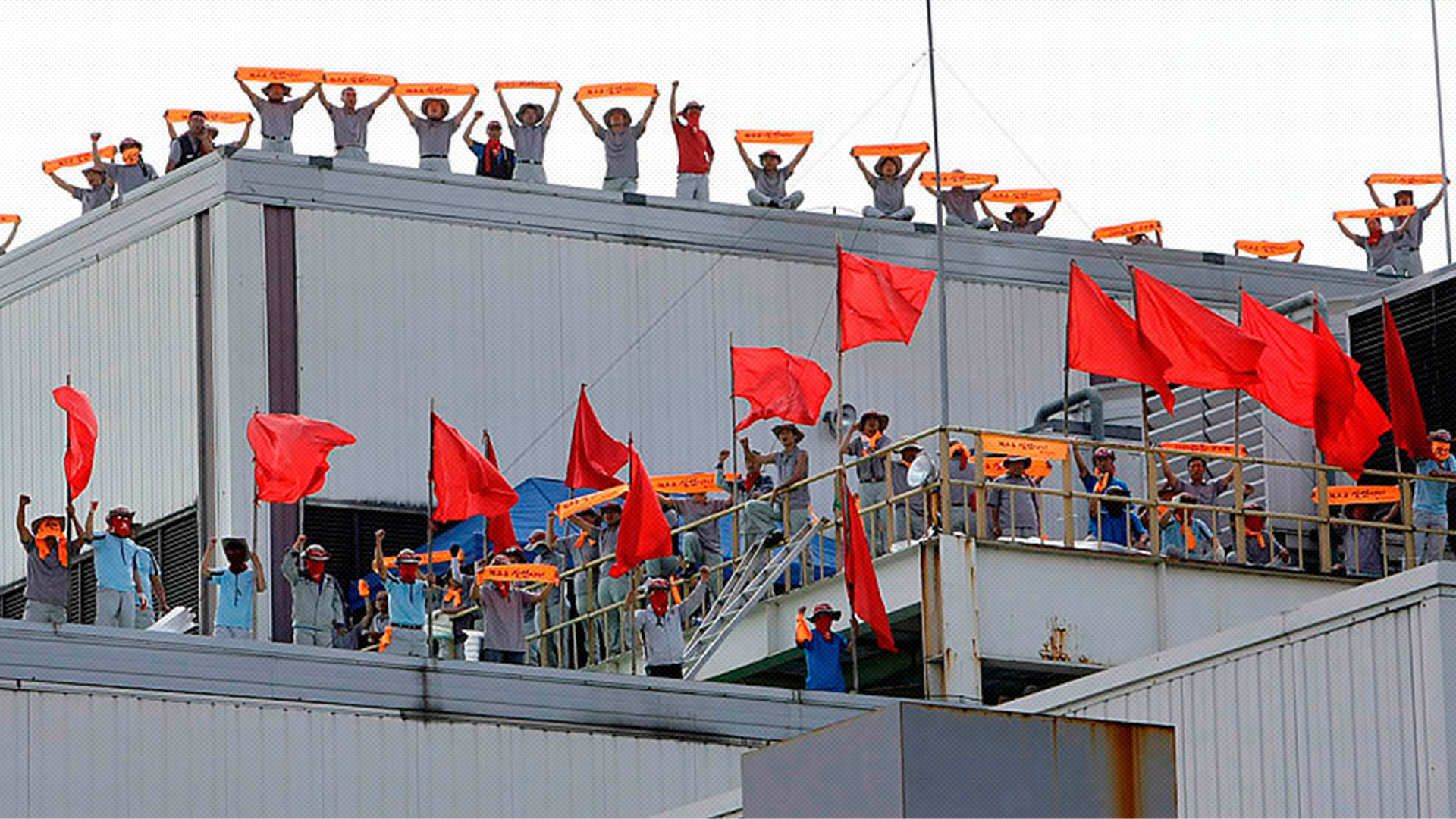The historic Ssangyong motors strike in 2009 is among the most fierce workers’ struggles South Korea has witnessed in almost two decades. Today, after the passage of more than a decade, 46 workers who were dismissed after the 77 days of occupation and fierce resistance by workers that year, continue their struggle for reinstatement which was promised by the company.
The agreement for the reinstatement of 119 dismissed workers came on September 14, 2018, after years of protests and sit-ins by the Korean Metal Workers’ Union (KMWU), the dismissed workers and their families. While some of the workers were reinstated in January 2019, 46 workers received a notice from Ssangyong motors (currently owned by Indian automobile manufacturer Mahindra & Mahindra) in December last year, saying that their reinstatement has been postponed.
“I wasn’t going to cry, but my eyes are tearing up because it’s raining. It’s supposed to be a happy day, but I’m feeling frustrated now because I received notice from the company on December 24 [2019] that my reinstatement was being postponed,” said 49-year-old Lee Deok-hwan while speaking to South Korea based The Hankyoreh.
On December 7, Deok-hwan along with other 45 workers decided to go to work despite their reinstatement being postponed by the company.
“I’m going to go inside the building [Ssangyong motors factory] to continue the fight,” added Deok-hwan.
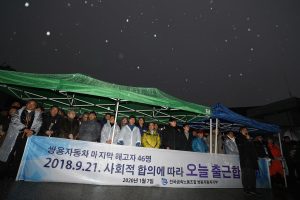
The strike that marked an era in South Korea’s working class history
For 77 days in 2009, South Korea’s Ssangyong motors’ Pyeongtaek plant was a battleground of class war. On one side there were around 1,000 workers – hungry, tired, but fighting for their rights, and on the other were thousands of heavily armed police personnel, company-hired thugs and an entire state machinery.
The labor dispute had begun in January 2009, when China’s Shanghai Automotive Industry Corporation (SAIC), which had a controlling stake in Ssangyong motors, filed for bankruptcy. Soon after, more than 2,500 workers were laid off.
According to the KMWU, SAIC’s bankruptcy filing was fraudulent and through the manipulation of books with the help of the accounting firm, Deloitte Anjin, to show that the company was facing financial exigencies. It was alleged that to qualify for bankruptcy, Deloitte Anjin with SAIC issued a company evaluation report on March 27, 2009, noting that the total tangible asset value of the company was USD 860 million, its debt ratio stood at 561%, with the net loss amounting to USD 700 million.
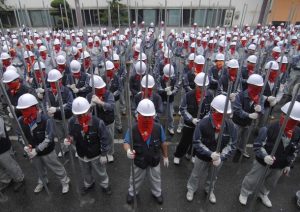
Meanwhile, an earlier evaluation report by the Korean Appraisal Board on March 10 had noted that the total tangible asset value of the company was USD 1.7 billion, the debt ratio was less than 561% and the net loss was less than USD 200 million. These figures didn’t qualify for bankruptcy.
In May, the company was placed under court receivership. The KMWU alleged that SAIC along with another accounting firm Samjong KPMG had used the evaluation report from Deloitte Anjin and submitted a restructuring plan that had led to 2646 workers being laid off.
The KMWU also alleged that SAIC’s primary interest in Ssangyong motors was to steal the government-funded technology of the Diesel Hybrid Engine and the newer models of Sports Utility Vehicle (SUVs). During the period of SAIC’s management of Ssangyong motors, no new investment was done nor newer SUV models produced, despite the company having the latest technologies.
A South Korean appeal court noted in a judgement that the company had exaggerated the financial crisis and did not go to sufficient lengths to save jobs.
Timeline: Workers raise the flag and occupy the factory
As the mass layoffs were announced by the company, thousands of workers declared a full strike and occupied the factory on May 21. Supported by the KMWU, the Korean Confederation of Trade Unions (KCTU), family members and workers of nearby factories, together prepared for a long battle. They created defensive fortifications around the factory to repel any attacks by the police and the company-hired guards. The core occupation of the plant was organized by 50 to 60 rank-and-file groups of 10 workers each, who in turn elected a delegate (chojang) for coordinated action.
The strike focused on three main demands: no layoffs, job security for all, and no outsourcing.
In the beginning, the company used private security guards and hired thugs to attack the striking workers. The police and the state was initially reluctant to get involved as the then right-wing government of Lee Myung-bak, elected in December 2007, was facing a major civil society uprising against his neoliberal and right-wing policies.
[Lee was later in 2018 convicted on the charges of bribery, embezzlement, and tax evasion alleged to have occurred during his presidency, and is carrying out a 15 year sentence.]
The Ssangyong management continuously refused to engage in negotiations with the KMWU (representing the striking workers), despite the union’s attempt to primarily focus on the issue of layoffs rather than job security and outsourcing.
Till July 2009, the striking workers resisted various attempts by the company-hired goons to remove them. In mid-July, the police launched a full blown assault on the factory with thousands of heavily armed riot police, water cannons and helicopters launching tear gas onto the roofs. The striking workers used improvised sling shots, Molotov cocktails, nuts and bolts, and even bare hands to resist the attack. Many workers were severely injured during the police operations, but refused to bow down and leave the factory.
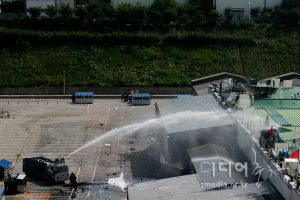
Meanwhile, the workers received massive domestic and international support and solidarity. The KMWU and KCTU organized a series of strikes in support of the Ssangyong workers, calling nearby factory workers to march towards the occupied factory in solidarity. On July 4th and July 11, the KCTU held nationwide labor rallies in support of the worker’s struggle. On July 16, thousands of KMWU members gathered to support the Ssangyong strike in front of the Pyeongtaek City Hall and attempted to march towards the factory with food and water, but were stopped by the police.
Following this, massive police attacks were launched on the factory occupied by hundreds of workers. Armed with a court order, on July 20, thousands of police and company thugs, backed by helicopters carrying a chemical that could melt Styrofoam, attacked the factory.
After multiple police operations, the striking workers strategically retreated to the company’s paint plant, knowing that police would not launch a massive attack on the plant as it contained thousands of gallons of highly flammable liquids.
Pitched battles were also fought on the streets outside the factory, where police violently repressed marches led by the KCTU and KMWU members and workers from nearby factories.
By the end of July, water supply to the plant was closed and families were not allowed to take food inside. The harsh conditions inside the plant forced few workers to leave, but they refused to denounce their striking colleagues, and instead declared their support for the occupation.
Amid the continuous physiological (round the clock hovering of police helicopters to deprive workers of sleep, and cutting down of electricity) and physical attacks by the police, on July 27, the striking workers organized a press conference and said, “….We have been doing our best to solve this dispute with the principle of peaceful settlement with dialogue. Nevertheless, if this kind of brutal, deadly repression continues, we openly declare our resolute will to fight to the death..”
After a series of failed negotiations and unilateral cancellations of talks by the company management, finally on August 6, the management and the KMWA agreed to end the strike with the following agreement:
An early retirement (i.e. layoff with severance pay) for 52% of the striking workers. 48% of workers to go on unpaid temporary leave for one year, after which they would be rehired, economic conditions permitting.
No investigations were ordered into the violent actions by the police and the company-hired guards, but many striking workers faced legal intimidation. Around 70 workers were jailed immediately at the end of the strike, many of them were released later. The leaders of the striking workers, Han Sang-qyun, Kwon Sun-man and Kim Hyuk, were imprisoned for 2-4 years.
The struggles continues
Despite the agreement, around 153 striking workers were dismissed. The company also reneged on its promise of taking back temporary workers. In November 2014, a high court ruled in favor of the dismissed workers and deemed the company’s action illegal. But the judgement was overruled in the same month by the supreme court.
The dismissed workers, along with their family and KMWU members, erected a ‘Hope Tent’ outside the Ssangyong plant to press their demand for reinstatement. In 2015, the company in negotiations with the KMWU agreed to take back the dismissed workers, a promise it never stood by.
It was finally in September 2018 that Ssangyong Motors (now owned by Mahindra & Mahindra) and the KMWU finalized an agreement to take back the workers who were fired for taking part in the 2009 strike. Though 119 workers were taken back in January 2019, others received a notice from the company that their reinstatement was being postponed due to “dull business”.
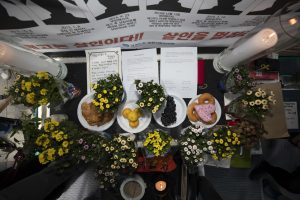
During and post the strike, more than 30 workers and family members died as a direct result of the mass layoffs and other intimidation by the company and the state. Some committed suicide, while others died of the trauma wrought by the company and state apparatus.
While it is a matter of debate whether the August 5 agreement to end the strike was a compromise, it remains that the battle fought by the Ssangyong workers inspired many working class struggles across the world.
The Ssangyong strike took place in a post economic recession scenario, where the recession had been used by international capital as a justification for the crackdown on unionization and workers’ rights. The historic 77 day strike in South Korea shook the national and international capitalist class, making it clear that the global recession caused by the capitalist model could not be used as an excuse to exploit workers.


